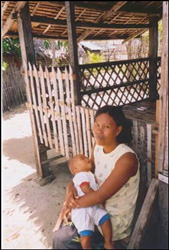
Photo: USAID/Virginia Foley
Marlyn Canete, the tour cooperative’s secretary, has new confidence in her child’s educational future because of the success of the cooperative.
|
Initiative
USAID funding enabled the Philippine Department of Environment and Natural Resources’ Coastal Resource Management Project (CRMP) to conduct a series of workshops for community members, acknowledging the residents’ goal to improve the well-being of their families by creating a profitable tourist destination from the region’s migratory bird flyway.
After a trial tour by international tourism experts in 1998, and earning an “A” rating, the authentic community ecotourism product was launched. In 1999, the cooperative took over administration of the tour operations and formalized collective ownership of the business. Word of mouth endorsements kept the community busy with an average of three tours a month.
Results
The Olango Birds and Seascape Tour, now managed by fifty-five cooperating community families, had thirty-three runs with 357 visitors during its introductory period, with 31% foreign guests from seventeen countries. More than thirty international organizations have visited the project. Familiarization tours were introduced for government agencies and tour operators to experience the potential of the project.
|


